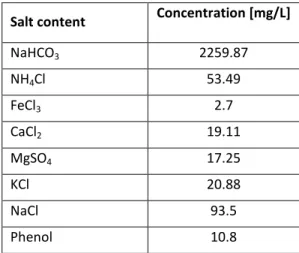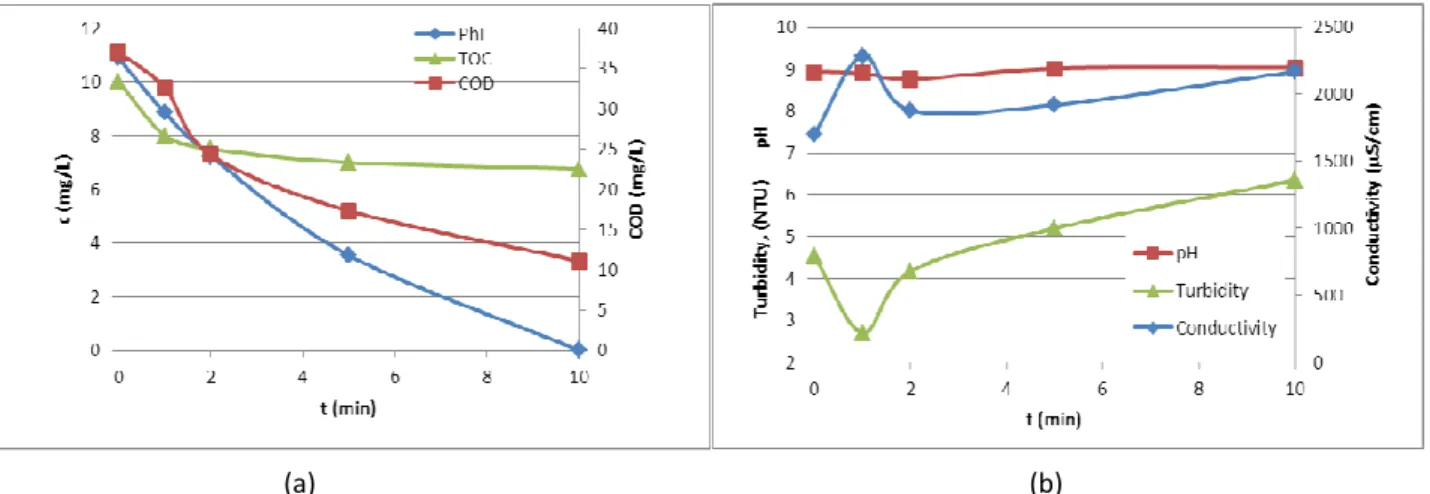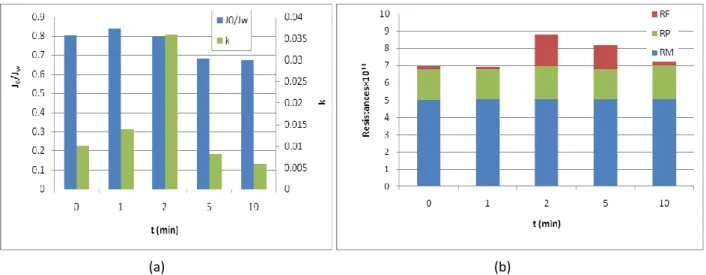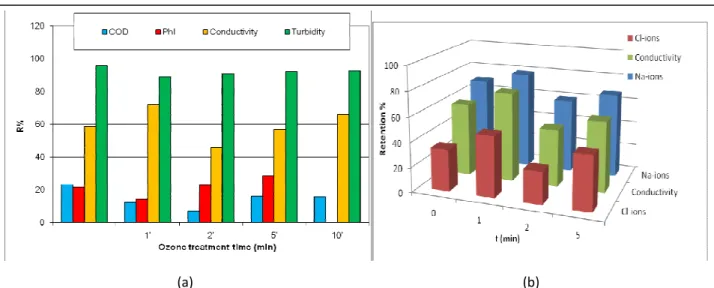A. Szép, Zs. L. Kiss, Sz. Kertész, C. Hodúr, Zs. László
Treatment of waste thermal waters by ozonation and nanofiltraton
A. Szép, PhD student, University of Szeged, Faculty of Engineering Zs. L. Kiss, PhD student, University of Szeged, Faculty of Engineering Sz. Kertész,
Research Fellow,University of Szeged, Faculty of Engineering C. Hodúr, Full professor, University of Szeged, Faculty of Engineering
Zs. László,Associate Professor, University of Szeged, Faculty of Engineering
Contact: Dr. Zsuzsanna László, University of Szeged, Faculty of Engineering, H-6725, Szeged, Moszkvai str, 9.
Tel: 00 36 62 546561, e-mail: zsizsu@sol.cc.u-szeged.hu
EXECUTIVE SUMMARY
In the southern part of Hungary thermal waters are widely used for heating e.g. greenhouses or housing estates. The residual thermal (waste) water may cause environmental problems due to their high ion content, sometimes high organic content related to high chemical oxygen demand or toxic compounds. The methods most frequently used to remove salinity are membrane separation processes. The main limitation of membrane processes is the flux decline caused by membrane fouling, which lowers the economical efficiency of membrane processes by reducing the rate of production treated water and shortening the membrane life. The aim of our work was to purify residual thermal water with high ion and phenolic contents and chemical oxygen demand (COD). This study was also designed to investigate the effects of ozone on the membrane flux, and of preozonation on the filtration efficiency.
During the experiments model thermal water was used. Ozone was produced from oxygen. The ozone-containing gas was bubbled continuously through a batch reactor during the treatment. The ozone concentrations of the bubbling gas before and after the reactor were followed by an UV spectrophotometer. The phenol index was measured with the help of photometric determination based on the 4-aminoantipyrine colour reaction. Determination of the COD was based on the standard method involving potassium-dichromate oxidation; TOC was measured by a TOC analyzer, Na and K content was measured by ion chromatograph; the conductivity, salinity and pH with an electrochemical multimeter. The membrane filtration measurements were carried out on laboratory membrane filter (UWATECH 3DTA) using nanofiltration membranes.
In the first series of experiments, the effect of ozone treatment on the concentration of organic (oxidizable) compounds was investigated. It was found that phenolic compounds can be eliminated from the water, while the total COD and TOC decreases slowly (81.8% and 35.7% could be eliminated respectively). The conductivity increased with ozonation time, which can be explained by arising small organic acids originated from phenol. This phenomenon is in accordance with the changes of pH: after short ozonation time the pH is decreased due to presence of organic acids, then the pH set back to the original value. The results showed that the nanofiltration alone greatly decrease the turbidity (nearly 100%), the COD (80%), but the phenol content has not decreased below the limit (3 mg/L) and the TOC decreased with only 20.95%. In the next series of experiments ozone treated thermal water was nanofiltered. It was found that the phenol retention decreases by ozone treatment due to decomposition of phenol molecules to small molecules, than after longer ozonation times it increases. The TOC removal increases with ozonation time; the retention of COD decreases after ozonation. The ion chromatographic measurements showed that preozonation changes the Na+ -ion and Cl- -ion retention during nanofiltration.
Summarizing the effect of ozone treatment, of nanofiltration and of nanofiltration after preozonation the elimination efficiency of COD, TOC, phenolic index and ion content were compared. The results show that the chemical oxygen demand and TOC can be effectively decreased by combination of ozone retreatment and membrane filtration. The ozone treatment is more effective for phenol elimination than nanofiltration alone – by combination of two processes 100% elimination efficiency can be achieved. The elimination efficiency of ion content by combined processes was
found to be similar to the efficiency of nanofiltration. It can be concluded that the combination of ozone treatment and nanofiltration is applicable to eliminate the organic pollutants from the water, but the ion content – although decreases by the treatment is more than 50% - remains high.
1 INTRODUCTION
In Hungary, mainly in the southern part of Hungary several thermal wells are operational. In Csongrád County alone, where 172 wells are located, the estimated thermal water production is over 20 million m3/year. The thermal water is used for balneological purposes, for public water supplies, and approximately 200 such wells are used for agricultural purposes, of which half produce water over 70 °C (Szanyi and Kovács, 2010). Injection into the porous Pannonian aquifers can be technically problematic, thus unfortunately, only about 20 are injection wells, which shows that the direct use of water without injection is the current standard, the waters became waste water after use. The residual water often has very high ion content, and many of them contain high amounts of organic compounds related to high chemical oxygen demand or toxic compounds, e.g. aromatic, and sometimes phenolic compounds (Kárpáti et al, 1999).
1.1 Background
The presence of phenols in waste thermal waters and finally in natural water sources may cause profound health and environmental problems. Physical, chemical and biological methods have been proposed for removing phenolic compounds from waste waters (Wang et al, 1997; Wilson et al, 1998), but these methods are not appropriate for reducing salt content of the water. Membrane process also may appropriate for elimination of phenolic compounds from water (Kujawski et al, 2004.), and the advantage of this method that considerable removal of salt content also can be achieved. Unfortunatelly, despite good rejection of salts, these processes often show low rejection for many small molecules, so hybrid processes have been developed and tested, including membrane separation combined with adsorption processes (Ipek, 2004) or bioreactors (Juang and Tsai, 2006; Barrios et al, 2006). Earlier studies showed that poor phenol rejection values were obtained using reverse osmosis membranes, while better results were obtained with nanofiltration membranes (Bódalo et al, 2009).
The main limitation of membrane processes is the flux decline caused by membrane fouling, which lowers the economical efficiency of membrane processes by reducing the rate of production treated water and shortening the membrane life. As the filtration process continues, fouling will eventually occur causing the permeate flux to decay with time. The decaying permeate flux is described by the power law:
t
bJ
J =
0⋅
− (1)where t is time [s], J0 is the initial flux and b is the fouling rate constant. Both J0 and b can be calculated from the measured data by using the curve-fitting technique.
In order to investigate the membrane fouling, the different fouling resistances were calculated. The rate and extent of membrane fouling and its effect on flux for any given systems depend on various parameters, such as the specific interactions between the membrane surface and various fouling species, hydrodynamic forces exerted by the flowing process fluid and process parameters such as the cross-flow velocity, TMP, feed concentration, pore size and temperature.
] h Lm [ −2 −1
=
M W W η R J Δp
(2)
where JW is the water flux of the clean membrane, ηW is the water viscosity [Pa*s], ∆p is the pressure difference between the two sides of the membrane [MPa] and RM is the membrane resistance.
RT is the total resistance [m–1], can be evaluated from the steady-state flux by using the resistance-in-series model:
] [ −1 +
+
= M F P m
T R R R
R (3)
where RF is the fouling resistance (mainly by the fouled pores) [m-1] and RP is the polarization layer resistance [m-1].
A. Szép, Zs. L. Kiss, Sz. Kertész, C. Hodúr, Zs. László The resistance of the polarization layer was determined after rinsing with deionized water to remove any particles residue layer from the surface of the membrane [13], by subtracting the resistance of the clean membrane. The resistances were calculated as
] m [ −1
=
W W M J η R Δp
(4)
] m [ −1
−
= M
W WA
F R
η J R Δp
(5)
] m [ −1
−
−
= M F
WW C
P R R
η J R Δp
(6) where JWA is the water flux after concentration tests, JC is the constant flux at the end of the concentration and ηWW is the wastewater viscosity.
The selectivity of a membrane for a given solute was expressed by the average rejection (R) [%]
100
−
= c0
1 c R
(7)
where c is the average concentration of the solute in the permeate phase, and c0 is the concentration of the solute in the feed.
Ozonation is one of the most promising processes with which to control the levels of organic pollutants in water. The application of ozonation as pretreatment before membrane filtration may reduce membrane fouling and enhance permeate flux (Hyung et al, 2000). Earlier studies showed that the effect of preozonation on membrane filtration parameters may be largely dependent on the quality of the raw water, since the characteristics of the foulants also control the rejection of other substances by the membrane (Schafer et al., 2000). The use of ozonation in combination with membrane filtration, and the effect of ozonation by-products on filtration parameters has not been extensively investigated. Earlier studies found that the use of the combined ozonation/filtration treatment system resulted in significant improvements in water quality compared to the filtration or ozonation alone (Karnik et al, 2005.).
1.2 Research objectives
In this study, we have investigated the quality of phenol containing thermal water after ozone treatment, nanofiltration and combined ozonation-membrane filtration. The quality of the treated thermal water was characterised by its conductivity, phenolic index and chemical oxygen demand. The effect of concentration of absorbed ozone on water quality and the quality of the permeate also was investigated.
2 METHODOLOGY
During the experiments synthetic thermal water was used, the content of thermal water was the same as a real thermal well in Szentes, Hungary. The content of the synthetic water is in Table 1.
TABLE 1 Composition of model thermal water
Salt content Concentration [mg/L]
NaHCO3 2259.87
NH4Cl 53.49
FeCl3 2.7
CaCl2 19.11
MgSO4 17.25
KCl 20.88
NaCl 93.5
Phenol 10.8
Ozone was produced from oxygen (Linde, 3.0) by a flow-type ozone-generator (Ozomatic Modular 4). The ozone- containing gas was bubbled continuously through a batch reactor during the treatment. The volume of the treated
water was 2 dm3. The treatment times were 1, 2, 5 and 10 min; the flow rate was 1 dm3min–1. The ozone concentrations of the bubbling gas before and after the reactor were followed by an UV spectrophotometer (WPA Lightwave S2000) at 254 nm.
The membrane filtration measurements were carried out on a Uwatech 3DTA laboratory membrane filter (Uwatech Gmbh., Germany) with a filtering surface area of 0.02 m². The membranes applied for nanofiltration: TFC SR3 (Koch membrane), composit poliamide membrane, 200 MWCO. The pressure values used: 2.0 MPa. The measurements were carried out at 20 °C. Temperature was measured with an alcoholic rod-thermometer, the conductivity, salinity and pH with a Consort C535 type equipment.
The phenol index was measured according to the specifications fixed in the norm MSz 1484-1:1992 (Water testing, determination of phenol index) with the help of photometric determination based on the 4-aminoantipyrine colour reaction. Determination of the COD was based on the standard method involving potassium-dichromate oxidation; for the analysis, standard test tubes (Lovibond) were used. The digestions were carried out in a COD digester (Lovibond, ET 108); the COD values were measured with a COD photometer (Lovibond PC-CheckIt).
For ion chromatographic determinations, aliquots of 0.50 mL of the reaction mixture were taken at regular time intervals and diluted to 10.00 mL. The obtained suspensions were filtered through membrane filters and analyzed on an ion chromatograph Dionex ICS 3000. For anion determination, use was made of an Ion Pac AS18 Analytical column (250mm×4mm) and a conductometric detector. The mobile phase was a solution of KOH (20–40 mM), flow rate 1 mL/min. Cations were determined using an Ion Pac CS12A Analytical column (250mm×4mm) and a conductometric detector. The mobile phase was a solution of 40 mM methane sulfonic acid at a flow rate of 1 mL/min.
For total organic carbon (TOC) analysis, samples were irradiated at different time intervals and analyzed after filtration on an Elementar Liquid TOC II analyzer.
3 RESULTS AND DISCUSSION
3.1 The effect of ozonation on water quality
In the first series of experiments, the effect of ozone treatment on the concentration of organic (oxidizable) compounds was investigated. Figure 1. demonstrates that phenolic compounds can be eliminated from the water, while the total organic carbon content and COD decreases slowly, due to the presence of remaining oxidation by- products of phenol.
(a) (b)
FIGURE 1 The effect of ozone treatment on phenolic index, total organic carbon and chemical oxygen demand of thermal water (a) and on conductivity and pH of thermal water (b)
The conductivity increased with ozonation time, which can be explained by arising small organic acids originated from phenol. This phenomena is in accordance with the changes of pH: after short ozonation time the pH is decreased due
A. Szép, Zs. L. Kiss, Sz. Kertész, C. Hodúr, Zs. László to presence of organic acids originated from degradation of phenol, then the pH set back to the original value.
Turbidity decreased after short term of ozonation then increased probably due to precipitation of ferric oxide.
3.2 Effect of ozone treatment on flux and fouling of the membrane
In the next series of experiments the effect of ozone pretreatment on membrane filtration parameters was investigated. The initial permeate flux normalised by water flux (J0/JW) and the fouling index k was computed by fitting Eq 1 to the measured data and is presented in the Fig. 2a. It was found that longer ozonation marginally decreased the initial permeate fluxes, but greatly decreased the fouling indexes, which means less fouling of membrane, thus the membrane flux will be maintainable for longer time.
The results show that the k fouling index is in a good correlation with fouling and polarization layer resistances. It was found that the ozone treatment had not a significant effect on polarization layer resistance, while the fouling resistance is the higher after 2 min ozonization. Longer time ozonization decrease the fouling resistance as the k fouling index too. This can be explained by appearance and diminishing of ozonation by-products of phenol. In the first stage of phenol degradation the aromatic ring is opening, this type if organic compounds may cause fouling. As the organic molecules degrade to smaller compounds the fouling resistance is decreased.
(a) (b)
FIGURE 2 The changes of initial permeate flux and fouling index in the function of preozonation time (a) and the membrane resistances of ozone treated solutions (b)
3.3 Retention of pollutants
We investigated that the nanofiltration alone may be applicable decreasing the phenol or ion content of the water.
During the experiments the membrane retention of phenol content, chemical oxygen demand, TOC and ion content was measured. The results showed that the nanofiltration alone greatly decrease the turbidity, the COD, but the phenol content has not decreased below the limit (3 mg/L). Although the conductivity greatly decreased, it is not enough to achieve the required 90% retention. It must be noted that the H of permeate is higher (9,14) than the feed solution (8,94) which means that the retention of hydrogen carbonate ions may be higher that Na+-ions, thus mainly these molecules may accumulate in polarization layer.
The retention values of untreated and ozone treated waters are shown in Fig. 3. It was found that the phenol retention decreases by ozone treatment due to decomposition of phenol molecules to small molecules, than after longer ozonation times it increases. On the other hand, the retention of COD decreases after ozonation. In order to demonstrate the effect of ozone treatment on retention of Na+-ions, chloride ions and conductivity are shown in Fig.
3.
(a) (b)
FIGURE 3 The retention values of untreated and ozone treated samples during nanofiltration (a) and retention of Na+-, Cl– -ions and conductivity in the function of ozonation time (b)
It was found that very good (70%) retention was achieved for Na+-ions, while the retention for chloride ions was about 30%. Short time ozone treatment increased the retention- both Na+ and Cl- -ions, which can be explained by the appearance of degradation products of phenol (ring-opening products), which may change the characteristic of polarization layer and paralelly increasing retention. Further ozone treatment lead to appearance of smaller organic molecules (decreasing pH (Fig. 1.) which may change the polarity of the pores by fouling of the membrane (Fig. 2.), thus decreasing the ion retention. As the organic molecules are oxidized the fouling is decreased and the ion retention is increased.
4 CONCLUSIONS
Summarizing the results the effect of ozone treatment, nanofiltration and nanofiltration in elimination efficency of COD, phenolic index and conductivity were compared (Fig. 4.) The results show that the chemical oxygen demand can be effectively decreased by combination of ozone retreatment and membrane filtration. The ozone treatment is more effective for phenol elimination than nanofiltration alone – by combination of two processes 100% elimination efficiency can be achieved. 60% of the ion content can be eliminated by nanofiltration, while ozone treatment is not decrease the ion content. The elimnation efficiency of combinated processes was found to be similar to the efficiency of nanofiltration.
It can be concluded that the combination of ozone treatment and nanofiltration is applicable to eliminate the organic pollutants from the water, but the ion content remaining high.
FIGURE 4 Elimination efficiency of COD, phenolic index and ion content during nanofiltration, ozone treatment and preozonation and nanofiltration
A. Szép, Zs. L. Kiss, Sz. Kertész, C. Hodúr, Zs. László
5 ACKNOWLEDGEMENTS
The authors are grateful for the financial support provided by the project „Optimization of Cost Effective and Environmentally Friendly Procedures for Treatment of Regional Water Resource” - IPA Cross-border cooperation program (Serbia-Hungary) HUSRB 0901 and the project TÁMOP-4.2.1/B-09/1/KONV-2010-005. The Project named
„TÁMOP-4.2.1/B-09/1/KONV-2010-0005 – Creating the Centre of Excellence at the University of Szeged” is supported by the European Union and co-financed by the European Regional Fund.
REFERENCES
Barrios, A. Barbot, E. Marrot, B. Moulin P.and Roche, N. (2006): Degradation of synthetic phenolcontaining wastewaters by MBR. J. Membr. Sci., 281 288–296
Bódalo, A. Gómez, E. Hidalgo, A.M. Gómez, M. Murcia, M.D. López, I. (2009): Nanofiltration membranes to reduce phenol concentration in wastewater, Desalination, 245, 680-686.
Hyung, H., Lee, S., Yoon, Y., Lee, C.-H. (2000): Effect of preozonation of flux and water quality in ozonation- ultrafiltration hybrid system for water treatment. Ozone Sci. Eng. 22. 637-652.
Ipek, U. (2004) Phenol removal capacity of RO with and without pre-treatment. Filt. Sep., 41(7), 39–40.
Juang R. and Tsai, S. (2006): Role of membrane-attached biofilm in the biodegradation of phenol and sodium salicylate in microporous membrane bioreactors. J. Membr. Sci., 283, 484–492.
Karnik, B.S., Davies, S.H., Baumann, M.J., Masten, S.J. (2005): The effects of combined ozonation and filtration on disinfection by-product formation, Water Research, 39 pp. 2839-2850.
Kárpáti, Z., Sajgó, Cs., Vető, I., Klopp, G., Horváth, I. (1999): Organic matter in thermal waters of the Pannonian Basin – a preliminary report on aromatic compounds, Organic Geochemistry, 30, 701-712.
Kujawski, W., Warszawski, A., Ratajczak, T., Porebski, W., Capala W., and Ostrowska, I. (204): Removal of phenol by different separation techniques. Desalination, 163 (1–3), 287–296
Schäfer, A.I., Fane, A.G., Waite T.D. (2000): Fouling effects on rejection in the membrane filtration of natural water,s Desalination 131(1-3), 215-224
Szanyi, J., Kovács, B. (2010): Utilization of geothermal systems in South-East Hungary, Geothermics 39(4), 357-364.
Wang, R.C., Kuo C.C., and Shyu, C.C. (1997) Adsorption of phenols onto granular activated carbon in a liquid–solid fluidized bed. J. Chem. Technol. Biotech., 68(2), 187–194.
Wilson, G.J., Khodadoust, A.P., Suidan, M.T., Brenner R.C.and Acheson C.M., (1998): Anaerobic/aerobic biodegradation of pentachlorophenol using GAC fluidized bed reactors: optimization of the empty bed contact time. Water Sci. Technol., 38(7), 9–17.



